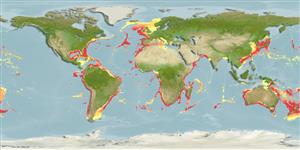Classification / Names
Common names from other countries
Main reference
Size / Weight / Age
Max length : 182 cm TL male/unsexed; (Ref. 10717)
Length at first maturity
Lm ?, range 117 - 159 cm
Environment
Marine; bathydemersal; depth range 37 - 1800 m (Ref. 247), usually 300 - 600 m (Ref. 247)
Climate / Range
Deep-water, preferred 22°C (Ref. 107945); 72°N - 56°S, 98°W - 153°W
Distribution
Western Atlantic: Georges Bank and northern Gulf of Mexico. Eastern Atlantic: Iceland (Ref. 12462), Scotland, and Irish Atlantic slope to Morocco, western Mediterranean, Madeira to Cameroon. Western Indian Ocean: Mozambique and South Africa. Western Pacific: Japan, Australia, and New Zealand. Central Pacific: Hawaii.
Countries | FAO areas | Ecosystems | Occurrences | Introductions
Short description
Dorsal
spines
(total): 0;
Dorsal
soft rays
(total): 0;
Anal
spines: 0;
Anal
soft rays: 0. Moderately sized, short- and blunt-snouted shark with two almost equal-sized dorsal fins; papillose thick lips; small slender-cusped upper teeth and very large lower teeth with erect triangular serrated cusps and distal blades; first dorsal fin on back with its origin behind the pectoral rear tips and its base closer to the pectoral base than the pelvic fins; and caudal fin with the ventral lobe not expanded (Ref. 247). Dark grey-brown to black; trailing edges of fins translucent (Ref. 26346).
IUCN Red List Status (Ref. 115185)
Threat to humans
Harmless
Human uses
Fisheries: minor commercial
More information
ReferencesAquacultureAquaculture profileStrainsGeneticsAllele frequenciesHeritabilityDiseasesProcessingMass conversion
Tools
Special reports
Download XML
Internet sources
Estimates of some properties based on models
Phylogenetic diversity index
PD50 = 1.0020 many relatives (e.g. carps) 0.5 - 2.0 few relatives (e.g. lungfishes)
Trophic Level
4.2 ±0.4 se; Based on diet studies.
Resilience
Low, minimum population doubling time 4.5 - 14 years (Fec=10-20)
Vulnerability
High to very high vulnerability (65 of 100)
Price category
